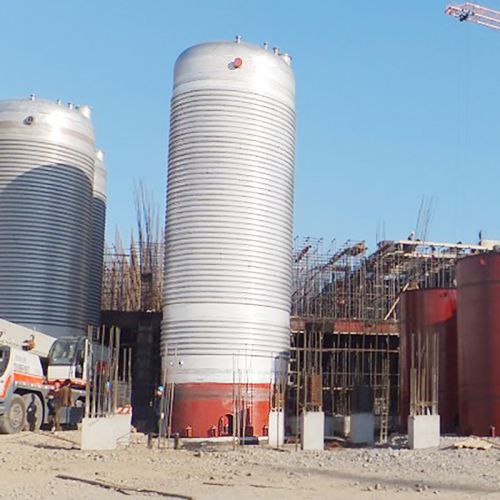Stainless steel can be divided into four categories according to the structure of its steel, namely austenitic stainless steel, ferritic stainless steel, martensitic stainless steel, austenitic-ferritic stainless steel.
Austenitic stainless steel and its fault preventions
Austenitic stainless steel is the most widely used kind of stainless steel for pressure vessels. At present, austenitic stainless steels can be roughly classified into Cr18-Ni8 type, Cr25-Ni20 type, and Cr25-Ni35 type.
1. Welding thermal cracks - Austenitic stainless steel has a small thermal expansion coefficient and a large coefficient of linear expansion. Therefore, during the welding process, the residence time of high temperature at the welded joint part is long, and the weld is likely to form a coarse columnar crystal structure during solidification and crystallization. If the content of impurity elements such as sulfur, phosphorus, tin, antimony and bismuth is high, a low-melting eutectic will be formed between the crystals, and when the welded joint is subjected to a high tensile stress, solidification cracks are easily formed in the weld, and liquation cracks are formed in the heat affected zone. (These two all belong to welding thermal cracks.) The most effective way to prevent thermal cracking is to reduce the impurity elements in steel that are prone to produce low-melting eutectic and let chromium-nickel austenitic stainless steel contain 4% to 12% ferritic.
2. Intergranular corrosion - According to the theory of chromium depletion, chromium carbide being precipitated on the intercrystalline is the main cause of intergranular corrosion. For this reason, the selection of ultra-low carbon welding materials that contain stabilizing elements such as antimony and titanium is the major measure to prevent intergranular corrosion.
3. Stress corrosion cracking - Stress corrosion cracking usually manifests as brittle failure, and the process of damage is short, so the damage is serious. The main cause of stress corrosion cracking of austenitic stainless steel is welding residual stress. The presence of structural changes or stress concentrations in the welded joints, and the concentration of localized corrosive media are also responsible for the stress corrosion cracking.
4. Sigma phase embrittlement of welded joints - Sigma phase is a brittle and hard intermetallic compound mainly concentrated in the grain boundaries of columnar crystals. Both the gamma phase and the delta phase can undergo a sigma phase transition. For example, when the Cr25Ni20 weld is heated at 800 °C - 900 °C, the gamma-to-delta transition will occur. For chrome-nickel austenitic stainless steels, especially chrome-nickel-molybdenum-type stainless steels, delta-sigma phase transition is prone to occur mainly due to the obvious sigma-forming effect of chromium and molybdenum, when the delta ferrite content in the weld exceeds 12%, the transformation of delta to sigma is very obvious, resulting in obvious embrittlement of the weld metal, which is why the inner wall of the hot wall hydrogenation reactor controls the delta ferrite content to 3% - 10%.
Ferritic stainless steel and its welding characteristics
Ferritic stainless steel can be divided into two types: normal ferritic stainless steel and ultra-pure ferritic stainless steel. Due to the high carbon and nitrogen content of normal ferritic stainless steel, it is difficult to form and weld, its corrosion resistance is hard to guarantee, and thus the use is limited. The carbon in steel is strictly controlled in ultra-pure ferritic stainless steel. The total amount of nitrogen is generally controlled at three levels: 0.035% - 0.045%, 0.030%, and 0.010% - 0.015%, and the necessary alloying elements are added to further improve the corrosion resistance and overall performance of the steel. Compared with normal ferritic stainless steel, ultra-pure high-chromium ferritic stainless steel has good resistance to pitting, uniform corrosion, and stress corrosion, and is widely used in petrochemical equipment.
Ferritic stainless steel has the following welding characteristics:
1. Under the high temperature of welding, the grain in the heat-affected zone with heating temperature above 1000 °C will grow sharply especially in the area near weld, and even if it is rapidly cooled after welding, the sharp drop of toughness caused by grain coarsening cannot be avoided. So there is a high tendency to intergranular corrosion.
2. Ferritic steel itself has a high chromium content, harmful elements such as carbon, nitrogen and oxygen, high brittle transition temperature and strong notch sensitivity. Therefore, its post-weld embrittlement is more serious.
3. When heated slowly at 400 °C - 600 °C for a long time, 475 °C embrittlement will occur, so that the toughness at the normal temperature is seriously reduced. After heating for a long time at 550 °C - 820 °C, the sigma phase is easily precipitated from the ferrite, and the plasticity and toughness are also significantly reduced.
Martensitic stainless steel and its welding characteristics
Martensitic stainless steel can be classified into Cr13 martensitic stainless steel, low carbon martensitic stainless steel and super martensitic stainless steel. Cr13 has general corrosion resistance. The Cr12-based martensitic stainless steel has high corrosion resistance and high temperature strength and oxidation resistance due to the addition of alloying elements such as nickel, molybdenum, tungsten and vanadium.
Welding characteristics of martensitic stainless steel:
Cr13 type martensitic stainless steel welds and heat-affected zone have a particularly strong tendency to harden. The welded joints can obtain hard and brittle martensite under air-cooling conditions, restraining stress and diffusing hydrogen in welding. Under the action of the welding, cold cracks are easy to appear in the welding. When the cooling rate is small, the near-weld area and the weld metal will form coarse ferrite and precipitate carbides along the crystal, which will significantly reduce the plasticity and toughness of the joint.
After the weld and heat affected zone of low carbon and super martensitic stainless steel are cooled, all of them are converted into low carbon martensite, but there is no obvious hardening phenomenon but a good welding performance.


 English
English Español
Español русский
русский